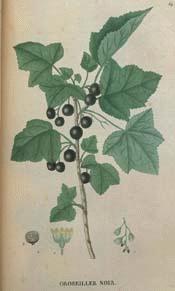
Botanical.com Home Page

|
Currant, Black
(Ribes nigrum)
Click on graphic for larger image
|
Currant, Black
Botanical: Ribes nigrum (LINN.)
Family: N.O. Saxifragaceae
---Synonyms---Quinsy Berries. Squinancy Berries.
---Parts Used---Fruit, leaves, bark, roots.
---Habitat---Europe.
---Description---The Black Currant is occasionally found wild in damp woods as far north as the middle of Scotland, but is considered to be a true native only in Yorkshire and the Lake District - when found apparently wild in other parts of the country, its presence is due to the agency of birds. It is easily distinguished at all seasons by the strong perfume of its buds and leaves.
This shrub shows the only instance of a process by which double flowers may become single, by changing petals into stamina. It has a solitary, one-flowered peduncle at the base of the raceme, and its leaves are dotted underneath.
It was not so popular originally as the Red and Whitc Currants, for Gerard describes the fruit as being 'of a stinking and somewhat loathing savour.'
The berries are sometimes put into brandy like Black Cherries. The Russians make wine of them, with or without honey or spirits, while in Siberia a drink is made of the leaves which, when young, make common spirits resemble brandy. An infusion of them is like green tea, and can change the flavour of black tea. Goats eat the leaves, and bears especially like the berries, which are supposed to have medicinal properties not possessed by others of the genus.
---Medicinal Uses---Diuretic, diaphoretic, febrifuge.
The juice can be boiled to an extract with sugar, when it is called Rob, and is used for inflammatory sore throats. Excellent lozenges are also prepared from it.
The infusion of the leaves is cleansing and diuretic, while an infusion of the young roots is useful in eruptive fevers and the dysenteric fevers of cattle.
The raw juice is diuretic and diaphoretic, and is an excellent beverage in febrile diseases.
A decoction of the bark has been found of value in calculus, dropsy, and haemorrhoidal tumours.
[Top]
RECIPES
Black Currant Jelly is deservedly prized for its usefulness in colds and is both laxative and cooling. It should not be made with too much sugar or its medicinal properties will be impaired. For a sore throat, take a tablespoonful of the jam or jelly; put it in a tumbler and fill the tumbler with boiling water. This 'Black Currant Tea' has a soothing, demulcent effect, taken several times in the day and drunk while hot.
A delicious wine can be made from the fruit. The following is a recipe from an old Cookery Book:
Black Currant Wine, very fine----To every 3 quarts of juice, put the same of water, unboiled; and to every 3 quarts of the liquor, add 3 lb . of very pure, moist sugar. Put it in a cask, preserving a little for filling up. Put the cask in a warm, dry room, and the liquor will ferment itself. Skim off the refuse, when the fermentation shall be over, and fill up with the reserved liquor. When it has ceased working, pour 3 quarts of brandy to 40 quarts of wine. Bung it close for nine months, then bottle it and drain the thick part through a jelly-bag, until it be clear, and bottle that. Keep it ten or twelve months.
Black Currant Cheese---is delicious and is made by putting equal parts of stalked currants and loaf sugar into a pan; place over low heat and stir until the sugar has dissolved, then bring slowly to the boil, stirring all the time. Remove all scum and simmer for an hour, stirring often. Rub the fruit through a hair sieve, return the puree to the pan, and stir until it boils, then put it into small pots and cover like jam.
[Top]
Common Name Index
A MODERN HERBAL Home Page
Bear in mind "A Modern Herbal" was written with the conventional wisdom of the early 1900's. This should be taken into account as some of the information may now be considered inaccurate, or not in accordance with modern medicine.
© Copyright Protected 1995-2024 Botanical.com
|

